Michael Greger's Blog, page 16
April 23, 2024
Morning Calories vs. Evening Calories
Why are calories eaten in the morning less fattening than calories eaten in the evening?
One reason calories consumed in the morning are less fattening than those eaten in the evening is that more calories are burned off in the morning due to diet-induced thermogenesis. That’s the amount of energy the body takes to digest and process a meal, given off in part as waste heat. If people are given the same meal in the morning, afternoon, or night, their body uses up about 25 percent more calories to process it in the afternoon than at night and about 50 percent more calories to digest it in the morning, as you can see below and at 0:36 in my video Eat More Calories in the Morning Than the Evening. That leaves fewer net calories in the morning to be stored as fat.
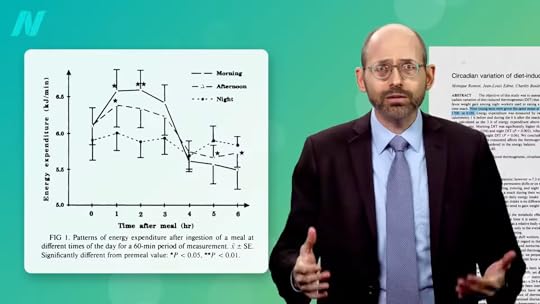
Let’s put some actual numbers to it. A group of Italian researchers randomized 20 people to eat the same standardized meal at either 8:00 am or 8:00 pm and had them return a week later to do the opposite. So, each person had a chance to eat the same meal for breakfast and dinner. After every meal, the study participants were placed in a “calorimeter” contraption to precisely measure how many calories they were burning over the next three hours. As you can see below and at 1:18 in my video, the researchers calculated that the meal given in the morning took about 300 calories to digest, whereas the same meal given at night only used up about 200 calories to process. The meal was about 1,200 calories, but, when eaten in the morning, it ended up only providing about 900 calories compared to more like 1,000 calories at night. Same meal, same food, same amount of food, but effectively 100 fewer calories when consumed in the morning rather than at night. So, a calorie is not just a calorie. It depends on when we eat it.
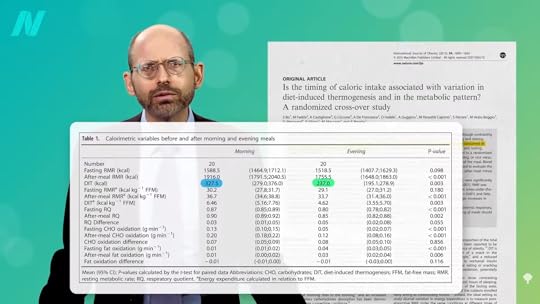
But why do we burn more calories when eating a morning meal? Is it behavioral or biological? If you started working the graveyard shift, sleeping during the day and working all night, which meal would net you fewer calories? Would it be the “breakfast” you had at night before you went to work or the “dinner” you had in the morning before you went to bed? In other words, is it something about eating before you go to sleep that causes your body to hold onto more calories, or is it built into our circadian rhythm, where we store more calories at night regardless of what we’re doing? You don’t know until you put it to the test.
Harvard researchers randomized people to identical meals at 8:00 am versus 8:00 pm while under simulated night shifts or day shifts. Regardless of activity level or sleeping cycle, the number of calories that were burned processing the morning meals was 50 percent higher than in the evening, as you can see in the graph below and at 2:45 in my video. So, the difference is explained by chronobiology: It’s just part of our circadian rhythm to burn more meal calories in the morning. But, why? What exactly is going on?
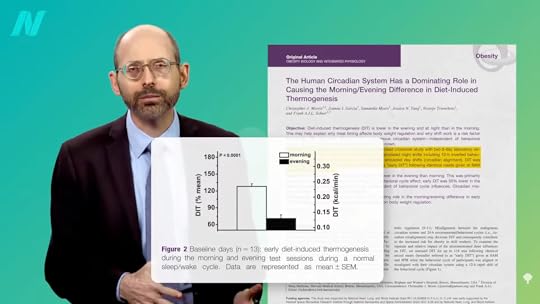
How does it make sense for our body to waste calories in the morning when we have the whole day ahead of us?
Our body isn’t so much wasting calories as investing them. When we eat in the morning, our body bulks up our muscles with glycogen, which is the primary energy reserve our body uses to fuel our muscles, but this takes energy. In the evening, our body expects to be sleeping for much of the next 12 hours, so rather than storing blood sugar as extra glycogen in our muscles, it preferentially uses it as an energy source, which may end up meaning we burn less of our backup fuel (body fat). In the morning, however, our body expects to be running around all day, so instead of just burning off breakfast, our body continues to dip into its fat stores while we use breakfast calories to stuff our muscles full of the energy reserves we need to move around over the day. That’s where the “inefficiency” may come from. The reason it costs more calories to process a morning meal is that, instead of just burning glucose (blood sugar) directly, our body uses up energy to string glucose molecules together into chains of glycogen in our muscles, which are then just going to be broken back down into glucose later in the day. That extra assembly/disassembly step takes energy—energy that our body takes out from the meal, leaving us with fewer calories.
So, in the morning, our muscles are especially sensitive to insulin, rapidly pulling blood sugar out of our bloodstream to build up glycogen reserves. At night, though, our muscles become relatively insulin-resistant and resist the signal to take in extra blood sugar. So, does that mean you get a higher blood sugar and insulin spike in the evening compared to eating the same meal in the morning? Yes. As you can see in the graph below and at 5:02 in my video, in that 100-calorie-difference study, for example, blood sugars rose twice as high after the 8:00 pm meal compared to the same meal eaten in the morning.
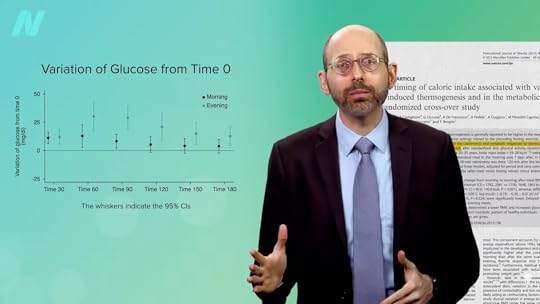
So, shifting the bulk of our caloric intake towards the morning would appear to have a dual benefit—more weight loss, and better blood sugar control, as shown in the graph below and at 5:12 in my video.
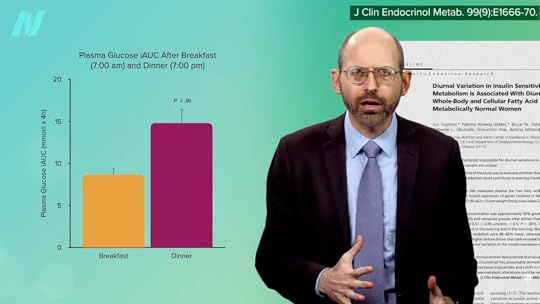
If you thought dual benefits sounded good, stay tuned for triple benefits! I dive deeper into circadian rhythms. See related posts below.
My last few videos (see below) focus on why science points to loading your calories towards the beginning of the day.
April 18, 2024
A King’s Breakfast, a Prince’s Lunch, and a Pauper’s Dinner
Harness the power of your circadian rhythms for weight loss by making breakfast or lunch your main meal of the day.
In my last chronobiology video, we learned that calories eaten at breakfast are significantly less fattening than the same number of calories eaten at dinner, as you can see at 0:14 in my video Breakfast Like a King, Lunch Like a Prince, Dinner Like a Pauper, but who eats just one meal a day?
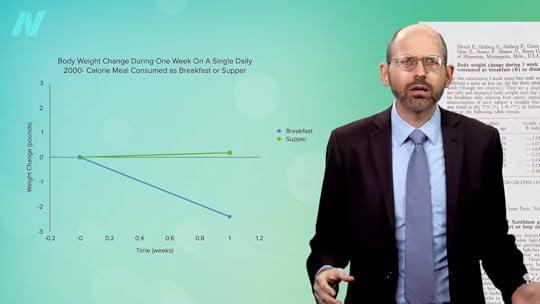
What about simply shifting our daily distribution of calories to earlier in the day? Israeli researchers randomized overweight and obese women into one of two isocaloric groups, meaning each group was given the same number of total calories. One group got a 700-calorie breakfast, a 500-calorie lunch, and a 200-calorie dinner, and the other group got the opposite—200 calories for breakfast, 500 for lunch, and 700 for dinner. Since all of the study participants were eating the same number of calories overall, the king-prince-pauper group should have lost the same amount of weight as the pauper-prince-king group, right? But, no. As you can see in the graph below and at 1:01 in my video, the bigger breakfast group lost more than twice as much weight, in addition to slimming about an extra two inches off their waistline. By the end of the 12-week study, the king-prince-pauper group lost 11 more pounds than the bigger dinner group, dropping 19 pounds compared to only 8 pounds lost by the pauper-prince-king group—despite eating the same number of calories. That’s the power of chronobiology, the power of our circadian rhythm.

What was the caloric distribution of the king-prince-pauper group getting 700 calories at breakfast, 500 at lunch, and 200 at dinner? They got 50 percent of calories at breakfast, 36 percent at lunch, and only 14 percent of calories at dinner, which is pretty skewed. What about 20 percent for dinner instead? A 50% – 30% – 20% spread, compared to 20% – 30% – 50%?
Again, the bigger breakfast group experienced “dramatically increased” weight loss, a difference of about nine pounds in eight weeks with no significant difference in overall caloric intake or physical activity between the groups, as shown in the graph below and at 1:57 in my video.
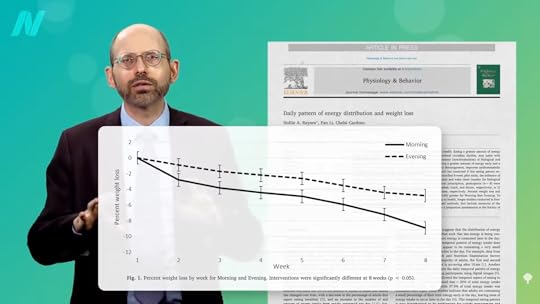
Instead of 80 percent of calories consumed at breakfast and lunch, what about 70 percent compared to 55 percent? Researchers randomized overweight “homemakers” to eat 70 percent of their calories at breakfast, a morning snack, and lunch, leaving 30 percent for an afternoon snack and dinner, or a more balanced 55 percent from the time they woke up through lunch. In both cases, only a minority of calories were eaten for dinner, as you can see below, and at 2:25 in my video. Was there any difference between eating 70 percent of calories through lunch versus only 55 percent? Yes, those eating more calories earlier in the day had significantly more weight loss and slimming.
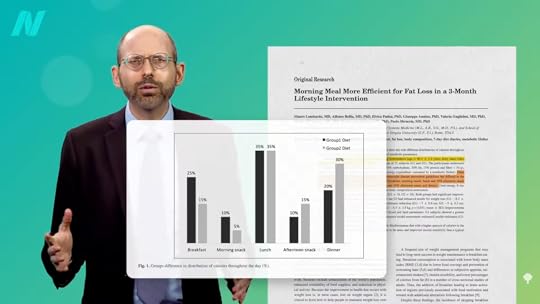
Concluded the researchers: “Stories about food and nutrition are in the news on an almost daily basis, but information can sometimes be confusing and contradictory. Clear messages should be proposed to reach the greatest number of people. One clear communication from physicians could be ‘If you want to lose weight, eat more in the morning than in the evening.’”
Even just telling people to eat their main meal at lunch rather than dinner may help. Despite comparable caloric intakes, participants in a weight-loss program randomized to get advice to make lunch their main meal beat out those who instead were told to make dinner their main meal.
The proverb “Eat breakfast like a king, lunch like a prince, and dinner like a pauper” evidently has another variant: “Eat breakfast yourself, share lunch with a friend, and give dinner away to your enemy.” I wouldn’t go that far, but there does appear to be a metabolic benefit to frontloading the bulk of your calories earlier in the day.
The evidence isn’t completely consistent, though. A review of dietary pattern studies questioned whether reducing evening intake would facilitate weight loss, citing a study that showed the evening-weighted group did better than the heavy-morning-meal group. Perhaps that was because the morning meal group was given “chocolate, cookies, cake, ice cream, chocolate mousse or donuts” for breakfast. So, chronobiology can be trumped by a junk-food methodology. Overall, the what is still more important than the when. Caloric timing may be used to accelerate weight loss, but it doesn’t substitute for a healthy diet. When he said there was a time for every purpose under heaven, Ecclesiastes probably wasn’t talking about donuts.
When I heard about this, what I wanted to know was how. Why does our body store less food as fat in the morning? I explore the mechanism in my next video, Eat More Calories in the Morning Than the Evening.
This is the fifth video in an 11-part series on chronobiology. If you missed the first four, check out the related posts below.
April 16, 2024
Fighting Cancer and the Common Cold with Garlic
Raw garlic is compared to roasted, stir-fried, simmered, and jarred garlic.
Garlic lowers blood pressure, regulates cholesterol, and stimulates immunity. I’ve talked before about its effect on heart disease risk factors, but what about immunity? Eating garlic appears to offer the best of both worlds, dampening the overreactive face of the immune system by suppressing inflammation while boosting protective immunity—for example, the activity of our natural killer cells, which our body uses to purge cells that have been stricken by viruses or cancer. “In World War II garlic was called ‘Russian Penicillin’ because, after running out of antibiotics, the soviet government turned to these ancient treatments for its soldiers,” but does it work? You don’t know until you put it to the test.
How about preventing the common cold? As I discuss in my video Benefits of Garlic for Fighting Cancer and the Common Cold, it is perhaps “the world’s most widespread viral infection, with most people suffering approximately two to five colds per year.” In the first study “to use a double-blind, placebo-controlled design to investigate prevention of viral disease with a garlic supplement,” those randomized to the garlic suffered 60 percent fewer colds and were affected 70 percent fewer days. So, those on garlic not only had fewer colds, but they also recovered faster, suffering only one and a half days instead of five. Accelerated relief, reduced symptom severity, and faster recovery to full fitness. Interesting, but that study was done about two decades ago. What about all of the other randomized controlled trials? There aren’t any. There’s only that one trial to date. Still, the best available balance of evidence suggests that, indeed, “garlic may prevent occurrences of the common cold.”
What about cancer? Is garlic “a stake through the heart of cancer?” As you can see below and at 2:05 in my video, various garlic supplements have been tested on cells in a petri dish or lab animals, but there weren’t any human studies to see if garlic could affect gene expression until now.
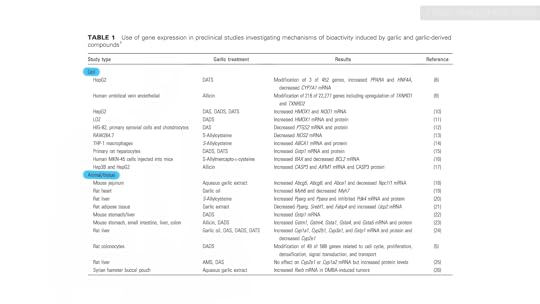
Researchers found that if you eat one big clove’s worth of crushed raw garlic, you get an alteration of the expression of your genes related to anti-cancer immunity within hours. You can see a big boost in the production of cancer-suppressing proteins like oncostatin when you drip garlic directly on cells in a petri dish, as shown in the graph below and at 2:25 in my video.
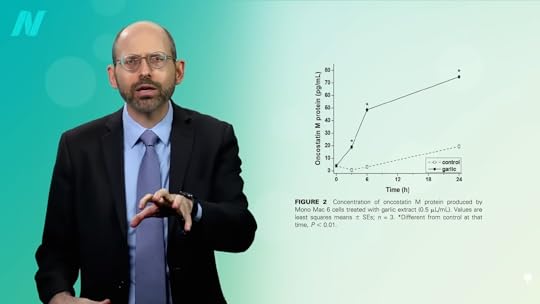
What’s more, you can also see boosted gene expression directly in your bloodstream within three hours of eating it, as seen below and at 2:34 in my video. Does this then translate into lower cancer risk?

As you can see in the graph below and at 2:44 in my video, after putting together ten population studies, researchers found that those reporting higher consumption of garlic only had half the risk of stomach cancer.

How do you define “high” garlic consumption? Each study was different, from a few times a month to every day. Regardless, those who ate more garlic appeared to have lower cancer rates than those who ate less, suggesting a protective effect. Stomach cancer is a leading cause of cancer-related death around the world, and garlic “is relatively cheap; the product is freely available and easy to incorporate into a daily diet in a palatable manner”—and safely, too, so why not? And, perhaps, the more, the better.
The only way to prove garlic can prevent cancer is to put it to the test. Thousands of individuals were randomized to receive seven years of a garlic supplement or a placebo. Those getting garlic did tend to get less cancer and die from less cancer, as you can see below and at 3:35 in my video, but the findings were not statistically significant, meaning that could have just happened by chance.

Why didn’t we see a more definitive result, given that garlic eaters appear to have much lower cancer rates? Well, the researchers didn’t give them garlic; they gave them garlic extract and oil pills. It’s possible that some of the purported active components weren’t preserved in supplement form. Indeed, one study of garlic supplements, for example, found that it might take up to 27 capsules to obtain the same amount of garlic goodness found in just half a clove of crushed raw garlic.
What happens if you cook garlic? If you compare raw chopped garlic to garlic simmered for 15 minutes, boiled for 6 minutes, or stir-fried for just 1 minute, you can get a three-fold drop in one of the purported active ingredients called allicin when you boil it, even more of a loss if you simmer it too long, and seemingly total elimination by even a single minute of stir-frying, as seen below and at 4:21 in my video. What about roasted garlic? Surprisingly, even though roasting is hotter than boiling, that cooking method preserved about twice as much. Raw garlic has the most, but it may be easier for some folks to eat two to three cloves of cooked garlic than even half a clove of raw.

What about pickled garlic or those jars of minced garlic packed in water or oil? Fancy, fermented black garlic? Though jarred garlic may be more convenient, they have comparatively less garlicky goodness, especially pickled garlic, and the black garlic falls far behind, as you can see in the graph below and at 5:12 in my video.
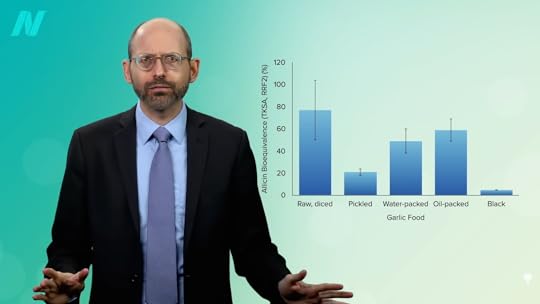
Can you eat too much? The garlic meta-analysis suggests there are no real safety concerns with side effects or overdosing, though that’s with internal use. You should not stick crushed garlic on your skin. It can cause irritation and, if left on long enough, can actually burn you. Wrap your knees with a garlic paste bandage or stick some on your back overnight, and you can end up burned, as seen below, and at 5:42 and 5:44 in my video.


Definitely don’t rub garlic on babies, even if you see an online article saying that topical garlic is good for respiratory disorders and your little one is congested. Below and at 5:57 in my video, you can see the blisters she got. The poor pumpkin! “It is crucial…to explain to patients that ‘natural’ does not equal ‘safe’…”

Don’t put it on your toes, don’t use it as a face mask, and don’t use it to try to get out of military service either.
If you just eat it like you’re supposed to, there shouldn’t be a problem. Some people can get an upset stomach if they eat too much, though, and you can’t really say there aren’t any side effects, given the “body odor and bad breath.”
The other video I mentioned is Friday Favorites: Benefits of Garlic Powder for Heart Disease. What else can garlic do? See related posts below.
And, for more on specific foods for fighting colds and cancer, check out related posts below.
April 11, 2024
Lose Weight by Eating More in the Morning
A calorie is not a calorie. It isn’t only what you eat, but when you eat.
Mice are nocturnal creatures. They eat during the night and sleep during the day. However, if you only feed mice during the day, they gain more weight than if they were fed a similar amount of calories at night. Same food and about the same amount of food, but different weight outcomes, as you can see in the graph below and at 0:18 in my video Eat More Calories in the Morning to Lose Weight, suggesting that eating at the “wrong” time may lead to disproportionate weight gain. In humans, the wrong time would presumably mean eating at night.

Recommendations for weight management often include advice to limit nighttime food consumption, but this was largely anecdotal until it was first studied experimentally in 2013. Researchers instructed a group of young men not to eat after 7:00 pm for two weeks. Compared to a control period during which they continued their regular habits, they ended up about two pounds lighter after the night-eating restriction. This is not surprising, given that dietary records show the study participants inadvertently ate fewer calories during that time. To see if timing has metabolic effects beyond just foreclosing eating opportunities, you’d have to force people to eat the same amount of the same food, but at different times of the day. The U.S. Army stepped forward to carry out just such an investigation.
In their first set of experiments, Army researchers had people eat a single meal a day either as breakfast or dinner. The results clearly showed the breakfast group lost more weight, as you can see in the graph below and at 1:35 in my video. When study participants ate only once a day at dinner, their weight didn’t change much, but when they ate once a day at breakfast, they lost about two pounds a week.
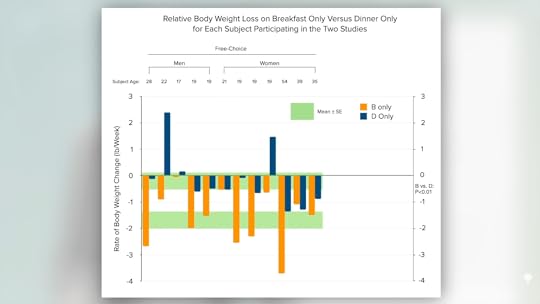
Similar to the night-eating restriction study, this is to be expected, given that people tend to be hungrier in the evening. Think about it. If you went nine hours without eating during the day, you’d be famished, but people go nine hours without eating overnight all the time and don’t wake up ravenous. There is a natural circadian rhythm to hunger that peaks around 8:00 pm and drops to its lowest level around 8:00 am, as you can see in the graph below and at 2:09 in my video. That may be why breakfast is typically the smallest meal of the day.

The circadian rhythm of our appetite isn’t just behavioral, but biological, too. It’s not just that we’re hungrier in the evening because we’ve been running around all day. If you stayed up all night and slept all day, you’d still be hungriest when you woke up that evening. To untangle the factors, scientists used what’s called a “forced desynchrony” protocol. Study participants stayed in a room without windows in constant, unchanging, dim light and slept in staggered 20-hour cycles to totally scramble them up. This went on for more than a week, so the subjects ended up eating and sleeping at different times throughout all phases of the day. Then, the researchers could see if cyclical phenomena are truly based on internal clocks or just a consequence of what you happen to be doing at the time.
For instance, there is a daily swing in our core body temperature, blood pressure, hormone production, digestion, immune activity, and almost everything else, but let’s use temperature as an example. As you can see in the graph below and at 3:21 in my video, our body temperature usually bottoms out around 4:00 am, dropping from 98.6°F (37°C) down to more like 97.6°F (36.4°C). Is this just because our body cools down as we sleep? No. By keeping people awake and busy for 24 hours straight, it can be shown experimentally that it happens at about the same time no matter what. It’s part of our circadian rhythm, just like our appetite. It makes sense, then, if you are only eating one meal per day and want to lose weight, you’d want to eat in the morning when your hunger hormones are at their lowest level. 
Sounds reasonable, but it starts to get weird.
The Army scientists repeated the experiment, but this time, they had the participants eat exactly 2,000 calories either as breakfast or as dinner, taking appetite out of the picture. The subjects weren’t allowed to exercise either. Same number of calories, so the same change in weight, right? No. As you can see in the graph below and at 4:18 in my video, the breakfast-only group still lost about two pounds a week compared to the dinner-only group. Two pounds of weight loss eating the same number of calories. That’s why this concept of chronobiology, meal timing—when to eat—is so important.

Isn’t that wild? Two pounds of weight loss a week eating the same number of calories! That was a pretty extreme study, though. What about just shifting a greater percentage of calories to earlier in the day? That’s the subject of my next video: Breakfast Like a King, Lunch Like a Prince, Dinner Like a Pauper. First, let’s take a break from chronobiology to look at the Benefits of Garlic for Fighting Cancer and the Common Cold. Then, we’ll resume checking other videos in the related posts below.
If you missed the first three videos in this extended series, also check out related posts below.
April 9, 2024
Circadian Rhythms and Our Health and Weight
Given the power of chronotherapy—how the same dose of the same drugs taken at a different time of day can have such different effects—it’s no surprise that chronoprevention approaches, like meal timing, can also make a difference.
The 2017 Nobel Prize in Medicine was awarded for “elucidating molecular mechanisms of the circadian clock,” our internal clock. For billions of years, life on Earth evolved to a 24-hour cycle of light and dark, so it’s no surprise our bodies are finely tuned to that pattern. But, even when we’re in total darkness without any external time cues, our body continues to cycle in about a 24-hour circadian rhythm. You can even take tissue biopsies from people and show the cells continue to cycle outside the body in a petri dish. Nearly every tissue and organ in our body has its internal clock.
An intricate system of intrinsic clocks drives not only some of our behavioral patterns, such as eating, fasting, sleeping, and wakefulness, but it also drives our internal physiology—our “body temperature, blood pressure, hormone production, digestion, and immune activity.” Most of the genes in our body “exhibit daily fluctuations in expression levels, making the circadian expression rhythms the largest known regulatory network in normal physiology,” the biggest regulatory system in our body. This cycling is thought to allow for a level of “‘predictability’ and ‘functional division of labor’” so that each of our body processes can run at the best time. At night while we’re sleeping, a whole array of internal housekeeping activities can be switched on, for example, and as dawn approaches, our body can shift back into activity mode.
Properly timed chemotherapy can not only end up being five times less toxic but also twice as effective against cancer. The same drugs, at the same dose, but with different effects depending on the time they’re given. Our body absorbs, distributes, metabolizes, and eliminates what we ingest differently, depending on when it is during the 24-hour cycle, as you can see below and at 2:19 in my video Chronobiology: How Circadian Rhythms Can Control Your Health and Weight.
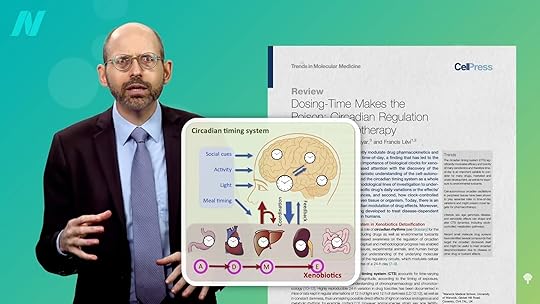
We’re just beginning to figure out the optimal timing for different medications. Randomize people suffering from hypertension into taking their blood pressure pills at bedtime instead of in the morning, and not only does the bedtime group achieve better blood pressure control and suffer fewer heart attacks and strokes, but they cut their risk of death in half. (Yet, most physicians and pharmacists tell patients to take them in the morning, potentially doubling their risk of death.) If chronotherapy—the optimal timing of drugs—can have such an impact, maybe it should come as no surprise that chronoprevention—the scheduling of lifestyle interventions like mealtimes—can also make a difference.
In the official Academy of Nutrition and Dietetics position paper on effective treatments for obesity, importance is placed not only on the quantity but also on the timing of caloric intake. “Potentially consuming more energy [calories] earlier in the day, rather than later in the day, can assist with weight management.” Some have gone further and even characterized obesity as a “chronobiological illness.” What evidence do we have to back up these kinds of claims?
Well, the “timing of energy [caloric] and nutrient intake has shifted slightly over time, with a greater proportion of intake later in the day,” raising the question about a possible role in the rise of obesity. Middle-aged men and women who eat a greater share of daily calories in the morning do seem to gain less weight over time, and a study entitled “Timing of Food Intake Predicts Weight Loss Effectiveness” found that dieters eating their main meal earlier in the day seemed to steadily lose more weight than those eating their main meal later, as you can see in the graph below and at 4:12 in my video.
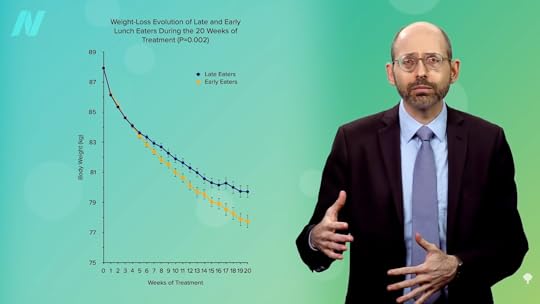
The obvious explanation for these findings would just be that those who eat later also tend to eat more. And, indeed, there does seem to be a relationship between when people eat most of their calories and how many calories they end up eating over the entire day, with those eating a greater proportion in the morning eating less overall. Maybe later eaters are overeating junk on the couch watching primetime TV? A tendency has been found for night owls to consume more fast food and soda, and fewer fruits and vegetables. In the field of social psychology, there is a controversial concept called “ego depletion,” where self-control is viewed as a limited resource, like a muscle that can become fatigued from overuse. As the day wears on, the ability to resist unhealthy food choices may decline, leaving one vulnerable to temptation. So, is it just a matter of later eating leading to greater eating?
In the study I mentioned above where earlier eaters steadily lost more weight, to the researchers’ surprise, the early eaters ate as much as the late eaters, despite the difference in weight-loss magnitude. By the end of the 20-week study, the early eaters ended up about five pounds lighter than the late eaters, even though the two groups ate the same amount of food. There didn’t seem to be any difference in physical activity between the two groups either. Could it be that just the timing itself of caloric intake matters? Scientists decided to put it to the test, which we’ll cover next.
Wasn’t that chemo data wild?
If you are on blood pressure medications, please share this video with your physician and ask if your timing is optimized.
We kicked off this chronobiology series by looking into the importance of breakfast when it comes to weight loss. In case you missed those videos, see Friday Favorites: Is Breakfast the Most Important Meal for Weight Loss, or Should It Be Skipped?.
For more on this topic, check out the related posts below.
April 4, 2024
Milk Hormones and Female Infertility
Dairy consumption is associated with years of advanced ovarian aging, thought to be due to the steroid hormones or endocrine-disrupting chemicals in cow’s milk.
When it comes to the amount of steroid hormones we are exposed to in the food supply, dairy “milk products supply about 60–80% of ingested female sex steroids.” I’ve talked about the effects of these estrogens and progesterone in men and prepubescent children, and how milk intake can spike estrogen levels within hours of consumption. You can see graphs illustrating these points from 0:25 in my video The Effects of Hormones in Milk on Infertility in Women. In terms of effects on women, I’ve discussed the increased endometrial cancer risk in postmenopausal women. What about reproductive-age women? Might dairy hormones affect reproduction?
We’ve known that “dairy food intake has been associated with infertility; however, little is known with regard to associations with reproductive hormones or anovulation.” How might dairy do it? By affecting how the uterus prepares, or by affecting the ovary itself? Researchers found that women who ate yogurt or cream had about twice the risk of sporadic anovulation, meaning failure of ovulation, so some months there was no egg to fertilize at all. Now, we know most yogurt is packed with sugar these days. Even plain Greek yogurt can have more sugar than a double chocolate glazed cake donut, but the researchers controlled for that and the results remained after adjusting for the sugar content, “which suggests that the risk of anovulation was independent of the sugar content included in many flavored yogurt products.” We don’t know if this was just a fluke or exactly what the mechanism might be, but if women skip ovulation here and there throughout their lives, might they end up with a larger ovarian reserve of eggs?
Women are starting to have their first baby later in life. As you can see in the graph below and at 2:02 in my video, there’s been a rise in women having babies when they’re in their late 30s and 40s.
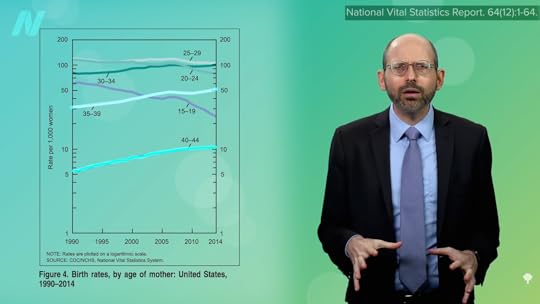
We used to think that women’s ovarian reserve of eggs stayed relatively stable until a rapid decline at about age 37, but now we know it appears to be more of a gradual loss of eggs over time. The graph below and at 2:22 in my video charts a steady loss starting at peak fertility in one’s 20s.
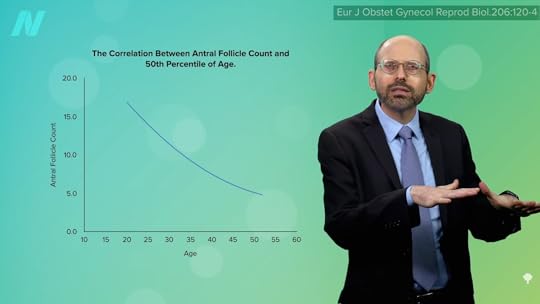
This measures “antral follicle count,” which is an ultrasound test where you can count the number of “next batter up” eggs in the ovaries, as you can see below and at 2:31 in my video. It is probably the best reflection of true reproductive age. It’s a measure of ovarian reserve—how many eggs a woman has left.

What does this have to do with diet? Researchers at Harvard looked at the association of various protein intakes with ovarian antral follicle counts among women having trouble getting pregnant. “Even though diminished ovarian reserve is one of the major causes of female infertility, the process leading to reproductive senescence [deterioration with age] currently is poorly understood. In light of emerging population trends towards delayed pregnancy, the identification of reversible factors (including diet) that affect the individual rates of reproductive decline might be of significant clinical value.”
The researchers performed ultrasounds on all the women, studied their diets, and concluded that higher intake of dairy protein was associated with lower antral follicle counts—in other words, accelerated ovarian aging. The graph below and at 3:39 in my video shows what counts look like in nonsmokers: Significantly lower ovarian reserve (12.7 antral follicle counts) at the highest dairy intake, which would be like three ounces of cheese a day, compared to the lowest dairy intake (16.9 antral follicle counts).

What do these numbers mean in terms of biological age? Is 16.9 down to 12.7 really that much of a difference? As you can see below and at 3:58 in my video, when you look at women with really robust ovaries, a follicle count of 16.9 is what you might see in a 36- or 37-year-old, whereas 12.7, which is what you can see in women eating the most dairy, is what you might see in a really fertile 50-year-old. So, we’re talking year’s worth of ovarian aging between the highest and lowest dairy consumers.
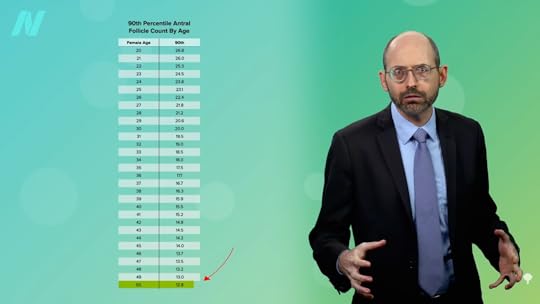
While it wasn’t possible for the researchers to “identify the underlying mechanism linking higher dairy protein intake to lower AFC,” antral follicle count, they had educated guesses. (1) It could be the steroid hormones and growth factors or (2) “the contamination of milk products by pesticides and endocrine disrupting chemicals that may negatively impact” the development of these ovarian follicles and egg competence.
“Regarding the former [the hormones], studies suggest that commercial milk (derived from both pregnant and non-pregnant animals) contains large amounts of estrogens, progesterone, and other placental hormones that are eventually released into the human food chain, with dairy intake accounting for 60–80% of the estrogens consumed. Dairy estrogens overcome [survive] processing, appear in raw whole cow’s and commercial milk products, are found in substantially higher concentrations with increasing amounts of milk fat, with no apparent difference between organic and conventional dairy products…” Hormones are just naturally in cows’ bodies, so they aren’t just in the ones injected with growth hormones. And, once these bovine hormones are inside the human body, they get converted to estrone and estradiol, the main active human estrogens. Following absorption, bovine steroids may then affect reproductive outcomes.
The researchers asserted that further studies are needed and that “it is imperative that these findings are reproduced in prospective studies designed to clarify the biology underlying the observed associations. The latter might be crucial given that consumption of another species’ milk by humans is an evolutionary novel dietary behavior that has the potential to alter reproductive parameters and may have long-term adverse health effects.”
The video I mentioned about the effects of these estrogens and progesterone in men and prepubescent children is The Effects of Hormones in Dairy Milk on Cancer.
I talk about the effect of dairy estrogen on male fertility in Dairy Estrogen and Male Fertility.
How else might diet affect fertility? See related posts below.
April 2, 2024
Skip Breakfast to Lose Weight?
Breakthroughs in the field of chronobiology—the study of our circadian rhythms—help solve the mystery of the missing morning calories in breakfast studies.
Where did this whole “breakfast is the most important meal of the day” concept come from? “The Father of Public Relations,” Edward Bernays, infamous for his “Torches of Freedom” campaign to get women to start smoking back in the 1920s, was paid by a bacon company to popularize the emblematic bacon-and-eggs breakfast. The role of public relations, he wrote in his book Propaganda, is the “conscious and intelligent manipulation of the organized habits and opinions of the masses….” Public relations specialists thereby “constitute an invisible government, which is the true ruling power of our country….”
Breakfast is big business. Powerful corporate interests, such as the cereal lobby, are blamed for “perpetuating myths such as the value of consuming breakfast.” An editorial in The American Journal of Clinical Nutrition urged nutrition scientists to speak truth to power and challenge conventional wisdom when necessary “even when it looks like we are taking away motherhood and apple pie.” “Actually,” the editorial concludes, “reducing the portion size of apple pie might not be a bad idea, either.”
So, should we “break the feast” and skip breakfast to lose weight? As I discuss in my video Is Skipping Breakfast Better for Weight Loss?, though “the advice to eliminate breakfast will surely pit…nutritional scientists…against the very strong and powerful food industry,” skipping breakfast has been described as “a straightforward and feasible strategy to reduce total daily energy [caloric] intake.” Unfortunately, it doesn’t seem to work.
Most randomized controlled studies of breakfast skipping found no weight-loss benefit to omitting breakfast. How is that possible if skipping breakfast means skipping calories? The Bath Breakfast Project, a famous series of experiments run not out of a tub, but the University of Bath in the UK, discovered a key to the mystery. Men and women were randomized to either eat breakfast (defined as taking in at least 700 calories before 11:00 am) or fast until noon every day. As you can see in the graph below and at 2:15 in my video, as in other similar trials, the breakfast-eating group ate a little less throughout the rest of the day but still ended up with hundreds of excess daily calories over the breakfast skippers.

Those who ate breakfast consumed more than 500 more calories a day. Over six weeks, that would add up to more than 20,000 extra calories. Yet, after six weeks, both groups ended up with the same change in body fat, as you can see below and at 2:36 in my video. How could tens of thousands of calories just effectively disappear?
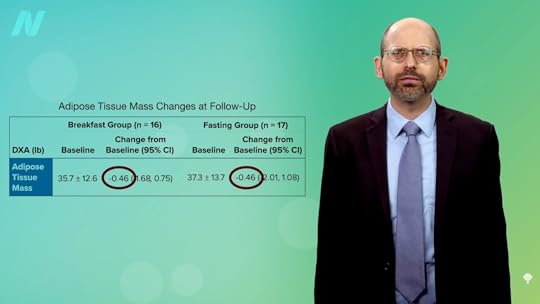
If more calories were going in with no change in weight, then there must have been more calories going out. And, indeed, as you can see in the graph below at 2:52 and in my video, the breakfast group was found to spontaneously engage in more light-intensity physical activity in the mornings than the breakfast-skipping group. Light-intensity activities include things like casual walking or light housecleaning, not structured exercise per se, but apparently, enough extra activity to use up the bulk of those excess breakfast calories. There’s a popular misconception that our body goes into energy conservation mode when we skip breakfast by slowing our metabolic rate. However, that does not appear to be true. But, maybe our body does intuitively slow us down in other ways. When we skip breakfast, our bodies just don’t seem to want to move around as much.

The extra activity didn’t completely make up for the added calories consumed by the breakfast group, though. We seem to still be missing about a hundred daily calories, suggesting there may be another factor to account for the mystery of the MIA morning calories. Recent breakthroughs in the field of chronobiology—the study of our body’s natural rhythms—have unsettled an even more sacred cow of nutrition dogma: the concept that a calorie is a calorie. It’s not just what we eat, but when we eat. Same number of calories, different weight loss, depending on meal timing.
Just to give you a taste: As you can see in the graph below and at 4:11 in my video, the exact same number of calories at breakfast are significantly less fattening than the same number of calories eaten at supper. Mind-blowing!
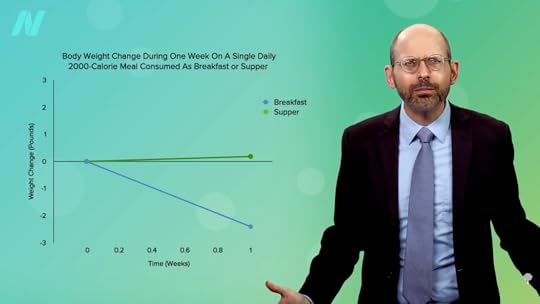
A diet with a bigger breakfast causes more weight loss than the same diet with a bigger dinner, as shown below and at 4:23 in my video. Because of our circadian rhythms, morning calories don’t appear to count as much as evening calories. So, maybe breakfast should be the most important meal of the day after all.

If you missed my last video, catch up with Flashback Friday: Is Breakfast the Most Important Meal for Weight Loss or Should It Be Skipped?.
Did I pique your interest in chronobiology? If so, you’re in luck. See more in the related posts below.
For some breakfast inspiration, check out A Better Breakfast and my recipe videos for a vegetable smoothie and a grain bowl from The How Not to Die Cookbook.
March 28, 2024
Daily Dozen–Inspired Recipes
Dr. Greger developed the Daily Dozen using the best available balance of evidence from scientific nutrition research. Rather than being a meal plan or diet in itself, the Daily Dozen is a checklist to inspire you to include some of the healthiest of healthy foods in your everyday routine and encourage you to design more balanced meals. The Daily Dozen is meant to serve as an aspirational minimum, so feel free to add even more whole, plant-based foods throughout your day.
Here are some recipes to help you check off some Daily Dozen boxes.
Brownie Sandwich CookiesCheck out our Brownie Sandwich Cookies for a fun way to incorporate beans into your desserts.
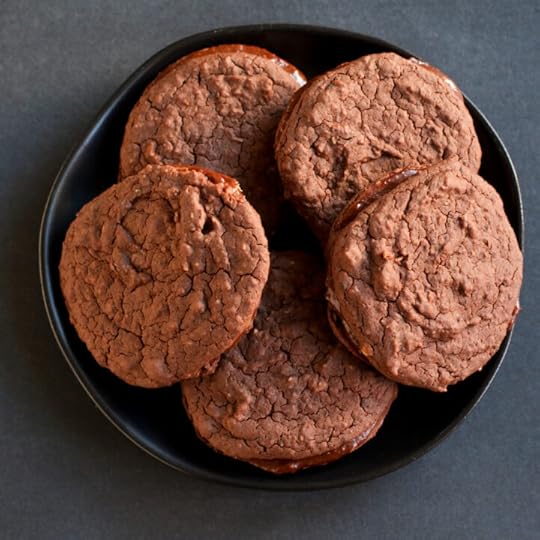
 Cheesy Broccoli Soup
Cheesy Broccoli Soup
The Cheesy Broccoli Soup from The How Not to Diet Cookbook is the perfect way to add some cruciferous vegetables to your meals. We eat first with our eyes, and the lovely green broccoli florets against a backdrop of cheesy broth will have you wanting to eat with your mouth, too.
Pre-Workout SmoothieWho doesn’t love a good smoothie? This Pre-Workout Smoothie is especially antioxidant-packed and has a beautiful color that is irresistible!
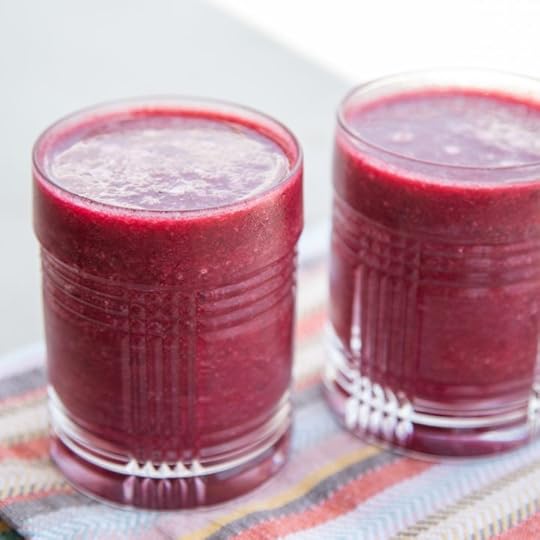
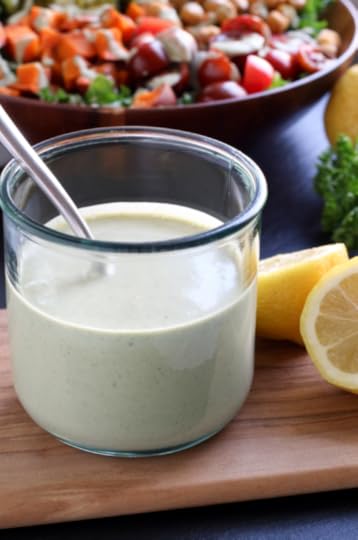 Sensational Tahini
–Dill Dressing
Sensational Tahini
–Dill DressingThis Sensational Tahini–Dill Dressing is a quick and delicious sauce that can be used in a variety of ways. Serve it over whole grain and bean bowls, chopped salads, roasted potatoes, or pasta salads.
Korean Soy Milk NoodlesKongguksu, Korean Soy Milk Noodles, combines a homemade soy broth with whole-grain buckwheat noodles and vegetables. The broth is usually served cold but can be enjoyed warm if desired. Feel free to top the dish with any additional vegetables of choice.
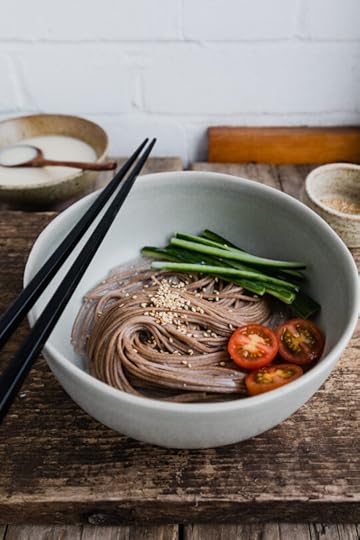
 Groatnola
Groatnola
Groatnola is a homemade, health-promoting breakfast cereal that’s made with simple whole food, plant-based ingredients. Treat the granola like regular breakfast cereal, and pair it with berries, walnuts, pumpkin seeds, ground flaxseed, and unsweetened soymilk. Use the granola with smoothie bowls or sprinkle it on top of nice cream.
We have many more recipes available on our whole food, plant-based recipes page.
If you’d like to share your experience with the Daily Dozen with your friends and family to help inspire them to include plant-based foods into their meals, check out our Daily Dozen Challenge! Together, we can help encourage more people to adopt healthier lifestyle habits. The English, Spanish, and Chinese versions of The Evidence-Based Eating Guide are available pre-printed through the DrGreger.org store and are 20% off through May 20, 2024.
Join us for eleven weeks of Daily Dozen support emails to help you Do the Dozen with ease. Each week, we will send you an email with tips, tricks, facts, and tasty recipes to help you incorporate some of the healthiest of healthy foods into your daily routine.
March 26, 2024
Are Branched-Chain Amino Acids Good for Us?
I discuss why we may not want to exceed the recommended intake of protein.
Diabetes isn’t just about the amount of body fat, but also the distribution of body fat. At 0:26 in my video Are BCAA (Branched-Chain Amino Acids) Healthy?, you can view cross-sections of thighs from two different patients using MRI. In the images, the fat shows up as white and the thigh muscle is black. At first glance, you might think the bottom cross-section has more fat since it’s ringed with more white. That is the subcutaneous fat, the fat under the skin. But, if you look at the top cross-section, you’ll see how the middle of the thigh muscle is more marbled with fat, like those really fatty Japanese beef steaks. That is the fat infiltrating into the muscle. In the graph below and at 0:48 in my video, the two cross sections are colored so you can see the different types of fat: the fat infiltrating the muscle in red, the fat between the muscles in green, and subcutaneous fat outside of the muscles and under the skin in yellow. If you add up all three types of fat, both of those thighs actually have the same amount of fat—just distributed differently.

This seems to be the critical factor in terms of determining insulin resistance, the cause of type 2 diabetes. Researchers found that the subcutaneous adipose tissue, the fat right under the skin, was not associated with insulin resistance. Going back to the two cross sections, as seen below and at 1:20 in my video, it is healthier to have the bottom thigh with the thicker ring of subcutaneous fat but less fat infiltrating muscle than the top thigh with more fat present in the muscle.

Is it possible a more plant-based diet also affects a more healthful distribution of fat?
We now know the effect of a vegetarian diet versus a conventional diabetic diet on thigh fat distribution in patients with type 2 diabetes. Researchers took 74 people with diabetes and randomly assigned them to follow either a vegetarian diet or a conventional diabetic diet. Both diets were calorie-restricted by the same number of calories. The vegetarian diet was also egg-free, and dairy was limited to a maximum of one serving of low-fat yogurt a day. What did the researchers find? The reduction in the more benign subcutaneous fat was comparable; it was about the same in both groups. However, the more dangerous fat—the fat lodged inside the muscle itself—“was reduced only in response to a vegetarian diet.” So, even getting the same number of calories, there can be a healthier weight loss on a more plant-based diet.
Those eating strictly plant-based also had lower levels of fat stuck inside the individual muscle fibers themselves, which may help explain why vegans in particular are often found to have the lowest odds of diabetes. It is not just because vegans are generally slimmer either. Even if you match subjects pound for pound, there is significantly less fat inside the muscle cells of vegans compared to omnivores. This is a good thing, since storing fat in muscle cells “may be one of the primary causes of insulin resistance,” which is what’s behind both prediabetes and type 2 diabetes. On the other hand, if you put someone on a high-fat diet, the fat in their muscle cells shoots up by 54 percent in just a single week.
What about a high-protein diet? That may undermine one of the principal benefits of weight loss: eliminating the weight-loss-induced improvement in insulin resistance. Researchers put obese individuals on a calorie-restricted diet of less than 1,400 calories a day until they lost 10 percent of their body weight. Half of the participants were getting more of a regular protein intake (73 grams a day), and the other half were on a higher-protein diet (about 105 daily grams). Normally, if you lose 10 percent of your body weight, your insulin resistance improves. That’s why it is so critical for obese individuals with type 2 diabetes to lose weight. However, the beneficial effect of a 10 percent weight loss was eliminated by the high protein intake. Those extra 32 grams of protein a day abolished the weight-loss benefit. “The failure to improve…insulin sensitivity in the WL-HP [weight-loss high-protein] group is clinically important because it reflects a failure to improve a major pathophysiological [cause-and-effect] mechanism involved in the development of T2D,” type 2 diabetes. In summary, the researchers concluded that they demonstrated “the protein content of a weight loss diet can have profound effects on metabolic function.”
Is this true of any protein? As you can see below and at 4:19 in my video, if you split it between animal protein versus plant protein, following people over time, intake of animal protein is associated with an increased risk of diabetes in most studies.

Intake of plant protein, however, appears to have either a neutral or even protective association with diabetes, as shown below and at 4:25 in my video.
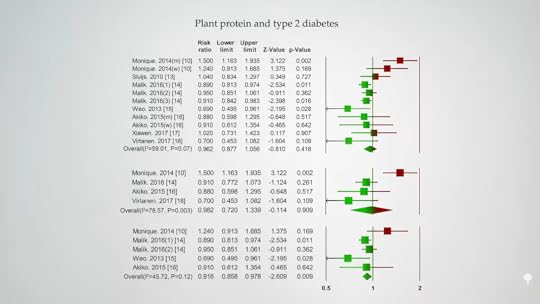
Those were just observational studies, though. People who eat a lot of animal protein might have many unhealthy behaviors. However, you see the same thing in randomized, controlled, interventional trials, where you can improve blood sugar control just by replacing sources of animal protein with plant protein.
We think it may be the branched-chain amino acids concentrated in animal protein. Higher levels in the bloodstream are associated with obesity and the development of insulin resistance. As you can see below and at 5:00 in my video, we may be able to drop our levels by sticking to plant proteins, but you don’t know if that has metabolic effects until you put it to the test.

Ruining the suspense, researchers titled their study: “Decreased Consumption of Branched-Chain Amino Acids Improves Metabolic Health.” They demonstrated that “a moderate reduction in total dietary protein or selected amino acids can rapidly improve metabolic health,” and this included improving blood sugar control, while also decreasing body mass index (BMI) and body fat. As you can see at 5:27 in my video, the protein-restricted group was eating hundreds more calories per day, significantly more calories than the control group, so they should have gained weight. But, no. They lost weight! After about a month and a half, they were eating more calories but lost more weight—about five more pounds than participants in the control group who were eating fewer calories, as you can see at 5:38 in my video. What’s more, this “protein restriction” had people eat the recommended amount of protein per day, about 56 daily grams. They should have been called the normal protein group or the recommended protein group instead, and the group eating more typically American protein levels and suffering because of it should have been called the excess protein group. Just sticking to the recommended protein intake doubled the levels of a pro-longevity hormone called FGF21, too, but we’ll save that for another discussion.
To better understand the negative impact of omnivores getting too much protein relative to vegetarians, see my video Flashback Friday: Do Vegetarians Get Enough Protein?.
I have several additional videos and blogs that may help explain some of the benefits of plant-based proteins. Check in the related posts below.
Of course, the best way to treat type 2 diabetes is to get rid of it by treating the underlying cause, as described in my video How Not to Die from Diabetes.









